|
PART 1 T O P I C |
|
|
|
|
|
|
|
|
|
|
|
|
|
|
|
|
|
|
|
CLICK BUTTON TO GO |
|
|
|
|
|
|
|
|
|
|
|
|
|
Videos |
|
|
|
|
|
|
|
|
|
|
|
|
JewishWikipedia.info
HOLOCAUST TRAINS, 1941 - 1944
Wikipedia
Location Nazi Germany, Occupied Poland; Belgium, Bulgaria, the Baltic states, Bessarabia, France, Greece, Hungary, Italy, Netherlands, Romania
Prisoner victims 4,000,000 (mostly Jews)
Destination Transit ghettos, Nazi concentration camps, forced labour and extermination camps
Holocaust trains were railway transports run by the Deutsche Reichsbahn national railway system under the strict supervision of the German Nazis and their allies, for the purpose of forcible deportation of the Jews, as well as other victims of the Holocaust, to the German Nazi concentration, forced labour, and extermination camps.
Modern historians suggest that without the mass transportation of the railways, the scale of the "Final Solution" would not have been possible. The extermination of people targeted in the "Final Solution" was dependent on two factors: the capacity of the death camps to gas the victims and "process" their bodies quickly enough and the capacity of the railways to transport the condemned prisoners from the Ghettos in Nazi-occupied Europe and Jewish ghettos in German-occupied Poland to selected extermination sites. The most modern accurate numbers on the scale of the "Final Solution" still rely partly on shipping records of the German railways.
PRE-WAR
The first mass deportation of Jews from Nazi Germany occurred in less than a year before the outbreak of war. It was the forcible eviction of German Jews with Polish citizenship fuelled by the Kristallnacht. Approximately 30,000 Jews were rounded up and sent via rail to refugee camps. In July 1938 both the United States and Britain at the Évian Conference in France refused to accept any more Jewish immigrants. The British Government agreed to take in the shipment of children arranged by Nicholas Winton in Prague, Czechoslovakia, on the conditions that he pay the cost (via Czech travel agency Cedok) and arrange for the foster care. Winton managed to arrange for 669 children to get out on eight trains to London (a small group of 15 were flown out via Sweden). The ninth train was to leave Prague on 3 September 1939, the day Britain entered World War II. The train never left the station, and none of the 250 children on board were seen again. All European Jews trapped under the Nazi regime became the target of Hitler's "Final Solution to the Jewish Question"
THE ROLE OF RAILWAYS IN THE FINAL SOLUTION
Within various phases of the Holocaust, the trains were employed differently. At first, they were used to concentrate the Jewish populations in the ghettos, and often to transport them to forced labour and German concentration camps for the purpose of economic exploitation. In 1939 for logistical reasons the Jewish communities in settlements without railway lines in occupied Poland were dissolved. By the end of 1941, about 3.5 million Polish Jews had been segregated and ghettoised by the SS in a massive deportation action involving the use of freight trains. Permanent ghettos had direct railway connections, because the food aid (paid by the Jews themselves) was completely dependent on the SS similar to all newly built labour camps. Jews were legally banned from baking bread. They were sealed off from the general public in hundreds of virtual prison-islands called Jüdischer Wohnbezirk or Wohngebiet der Juden. However, the new system was unsustainable. By the end of 1941, most ghettoised Jews had no savings left to pay the SS for further bulk food deliveries. The quagmire was resolved at the Wannsee conference of 20 January 1942 near Berlin, where the "Final Solution" (die Endlösung der Judenfrage) was set in place. It was a euphemism referring to the Nazi plan for the annihilation of the Jewish people.
During the liquidation of the ghettos starting in 1942, the trains were used to transport the condemned populations to death camps. To implement the "Final Solution", the Nazis made their own Deutsche Reichsbahn an indispensable element of the mass extermination machine, wrote historian Raul Hilberg. Although the prisoner trains took away valuable track space, they allowed for the mass scale and shortened duration over which the extermination needed to take place. The fully enclosed nature of the locked and windowless cattle wagons greatly reduced the number and skill of troops required to transport the condemned Jews to their destinations. The use of railroads enabled the Nazis to lie about the "resettlement program" and, at the same time, build and operate more efficient gassing facilities which required limited supervision.
The Nazis disguised their "Final Solution" as the mass "resettlement to the east". The victims were told they were being taken to labour camps in Ukraine. In reality, from 1942 on for most Jews, deportations meant only death at either Bełżec, Chełmno, Sobibór, Majdanek, Treblinka, or Auschwitz-Birkenau. Some trains that had already transported goods to the Eastern front on their return carried human cargo bound for extermination camps. The plan was being realized in the utmost secrecy. In late 1942 during a telephone conversation Hitler's private secretary Martin Bormann admonished Heinrich Himmler who was informing him about 50,000 Jews already exterminated in a concentration camp in Poland. "They were not exterminated – Bormann screamed – only evacuated, evacuated, evacuated!" and slammed down the phone, wrote Enghelberg.
SCALE OF THE NEED FOR MASS TRANSPORTATION
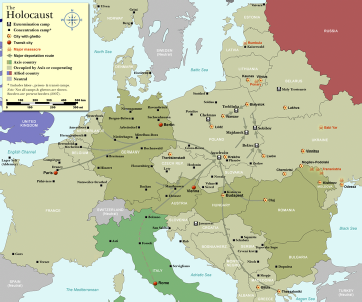 Map of the Holocaust in Europe during World War II, 1939-1945
Map of the Holocaust in Europe during World War II, 1939-1945
showing German Nazi extermination/death camps, most major concentration camps, labor camps, prison camps, ghettos, major deportation routes and major massacre sites.
NOTES:
1. Extermination camps were dedicated death camps,
but all camps and ghettos took a toll of many, many lives.
2. Concentration camps include labor, prison & transit camps.
3. Not all camps & ghettos are shown.
4. Borders are at the height of Axis domination (1942).
5. Some regions have German designations (e.g. "Ostland"), with the present country name denoted in uppercase letters in parenthesis below the German designation (e.g. "(AUSTRIA)").
6. Present (2007) borders are dotted.
Following the Wannsee Conference of 1942, the Nazis began to murder the Jews in large numbers at newly built death camps of Operation Reinhard. Since 1941, the Einsatzgruppen, mobile extermination squads, were already conducting mass shootings of Jews in the Eastern territories which were occupied earlier by the Soviet Union, as well as east of the 1939 Soviet borders . The Jews of Western Europe were either deported to ghettos emptied through mass killings, such as the Rumbula massacre of the inhabitants of the Riga Ghetto, or sent directly to Treblinka, Belzec and Sobibór extermination camps built in spring and summer of 1942 only for gassing. Auschwitz II Birkenau chambers began operating in March. The last death camp, Majdanek, launched them in late 1942.
At Wannsee, the SS estimated that the "Final Solution" could ultimately eradicate up to 11 million European Jews; Nazi planners envisioned the inclusion of Jews living in neutral and non-occupied countries such as Ireland, Sweden, Turkey, and the United Kingdom. Deportations on this scale required the coordination of numerous German government ministries and state organisations, including the Reich Main Security Office (RSHA), the Transport Ministry, and the Foreign Office. The RSHA coordinated and directed the deportations; the Transport Ministry organized train schedules; and the Foreign Office negotiated with German-allied states and their railways about "processing" their own Jews.
In recent years, the German spokesman for the Train of Commemoration remembrance project, Hans-Rüdiger Minow told The Jerusalem Post that from among the World War II railway staff and officials, there is "no word about those who committed the crimes" even though 200,000 train employees were involved in the rail deportations and "10,000 to 20,000 were responsible for mass murders". The railwaymen were never prosecuted.
THE JOURNEY
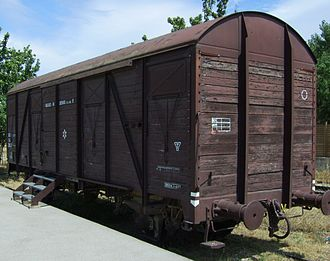
The first trains with German Jews expelled to ghettos in occupied Poland began departing from central Germany on 16 October 1941. Subsequently called Sonderzüge (special trains), they had low priority for the movement and would proceed to the mainline only after other transports went through. This led to longer journeys and deaths in the boxcar ‘carriage’.
Trains differed with some third class passenger carriages, but were mainly freight cars or cattle cars which were packed with up to 150 deportees, although 50 was the number proposed by SS regulations. No food or water was supplied. The Güterwagen boxcars were only fitted with a bucket latrine. A small barred window provided irregular ventilation, which oftentimes resulted in multiple deaths from either suffocation or the exposure to the elements. Some freight cars had a layer of quick lime on the floor.
At times the Germans did not have enough filled up cars ready to start a major shipment of Jews to the camps,so the victims were kept locked inside overnight at layover yards. The Holocaust trains waited for more important military trains to pass. An average transport took about four days. The longest transport of the war, from Corfu, took 18 days. When the train arrived at the camp and the doors were opened, everyone was already dead.
Due to delays and cramped conditions, many deportees died in transit. On 18 August 1942, Waffen SS officer Kurt Gerstein had witnessed at Belzec the arrival of "45 wagons with 6,700 people of whom 1,450 were already dead on arrival." That train came with the Jews of the Lwów Ghetto, less than a hundred kilometers away.
POINT OF ARRIVAL
The SS built three extermination camps in occupied Poland specifically for Operation Reinhard: Bełżec, Sobibór, and Treblinka. They were fitted with identical mass killing facilities disguised as communal shower rooms. In addition, gas chambers were developed in 1942 at the Majdanek concentration camp,and at Auschwitz II-Birkenau. In German-occupied USSR at the Maly Trostinets extermination camp shootings were used to kill victims in the woods. At the Chełmno extermination camp victims were killed in gas vans whose redirected exhaust fed into sealed compartments at the rear of the vehicle. They were utilized in Trostinets as well. Neither of these two camps had international rail connections therefore the trains used to stop at the nearby ghettos in Łódź and in Minsk respectively. From there, the prisoners were taken by trucks to die. At Treblinka, Belzec, and Sobibor the killing mechanism consisted of a large internal-combustion engine delivering exhaust fumes to gas chambers through pipes. At Auschwitz and Majdanek, the gas chambers relied on Zyklon B pellets of hydrogen cyanide, poured through vents in the roof from cans sealed hermetically.
Once alighted, the prisoners were split by category. The old, the young, the sick and the infirm were sometimes separated for immediate death by shooting, while the rest were prepared for the gas chambers. In a single 14-hour workday, 12,000 to 15,000 people would be killed at any one of these camps. The capacity of the crematoria at Birkenau was 20,000 bodies per day. The selected new arrivals who looked healthy were put to slave labor in the Sonderkommandos, burying victims in mass graves and burning corpses under pain of death.
THE CALCULATIONS
Interior of a boxcar used to transport Jews and other Holocaust victims during World War II, the United States Holocaust Memorial Museum in Washington, D.C.
The standard means of delivery was a 10 metre long cattle freight wagon, although third class passenger carriages were also used when the SS wanted to keep up the "resettlement to work in the East" myth, particularly in the Netherlands and in Belgium. The SS manual covered such trains, suggesting a carrying capacity per each trainset of 2,500 people in 50 cars, each boxcar loaded with 50 prisoners. In reality however, boxcars were crammed with up to 100 persons and routinely loaded from the minimum of 150% to 200% capacity. This resulted in an average of 5,000 people per trainset; 100 persons in each freight car multiplied by 50 cars. Notably, during the mass deportation of Jews from the Warsaw Ghetto to Treblinka in 1942 trains carried up to 7,000 victims each.
In total, over 1,600 trains were organised by the German Transport Ministry, and logged mainly by the Polish state railway company taken over by Germany, due to the majority of death camps being located in occupied Poland. Between 1941 and December 1944, the official date of closing of the Auschwitz-Birkenau complex, the transport/arrival timetable was of 1.5 trains per day: 50 freight cars × 50 prisoners per freight car × 1,066 days = 4,000,000 prisoners in total.
On 20 January 1943, Himmler sent a letter to Albert Ganzenmüller, the Under-secretary of State at the Reich Transport Ministry, pledging: "need your help and support. If I am to wind things up quickly, I must have more trains." Of the estimated 6 million Jews exterminated during World War II, 2 million were murdered on the spot by the military, political police, and mobile death squads of the Einsatzgruppen aided by the Orpo battalions and their auxiliaries. The remainder were shipped to their deaths elsewhere.
Payment
Most of the Jews were forced to pay for their own deportations, particularly wherever passenger carriages were used. This payment came in the form of direct money deposit to the SS in light of the "resettlement to work in the East" myth. Charged in the ghettos for accommodation the adult Jews paid full price one-way tickets, while children under 10–12 years of age paid half price. Those who were running out of money in the ghetto were loaded onto trains to the East as first, while those with some remaining supplies of gold and cash were shipped as last.
The SS forwarded part of this money to the German Transport Authority to pay the German Railways for transport of the Jews. The Reichsbahn was paid the equivalent of a third class railway ticket for every prisoner transported to their destination: 8,000,000 passengers 4 Pfennig per track kilometer, times 600 km (average voyage length), equaled 240 million Reichsmarks. Children under four went free.
The Reichsbahn pocketed both this money and their own share of the cash paid by the transported Jews after the SS fees. According to an expert report established on behalf of the German "Train of Commemoration" project, the receipts taken in by the state-owned Deutsche Reichsbahn for mass deportations in the period between 1938 and 1945 reached a sum of US $664,525,820.34.
OPERATIONS ACROSS EUROPE
Powered mainly by efficient steam locomotives, the Holocaust trains were kept to a maximum of 55 freight cars on average, loaded from 150% to 200% capacity. The participation of German State Railway (the Deutsche Reichsbahn) was crucial to the effective implementation of the "Final Solution of the Jewish Question". The DRB was paid to transport Jews and other victims of the Holocaust from thousands of towns and cities throughout Europe to meet their death in the Nazi concentration camp system.
As well as transporting German Jews, DRB was responsible for coordinating transports on the rail networks of occupied territories and Germany's allies. The characteristics of organized concentration and transportation of victims of the Holocaust varied by country
(for detail go to Wikipedia)
.
5.1 Belgium
5.2 Bulgaria
5.3 Bohemia and Moravia
5.4 France
5.5 Greece
5.6 Hungary
5.7 Italy
5.8 Netherlands
5.9 Poland
5.10 Romania
5.11 Scandinavia
5.12 Slovakia
5.13 Switzerland
GERMAN RAILWAYS ADMITS COMPLICITY IN HOLOCAUST
The Guardian, Kate Connolly, Wednesday 23 January 2008
German railways today admitted the central role its Nazi-era predecessor played in the Holocaust, saying that without the cooperation of the network the systematic murder of millions of people could never have happened.
Launching its first ever touring exhibition about the Holocaust, the state rail company Deutsche Bahn (DB) said the tracks and freight of the Reichsbahn were integral to the Nazis' extermination plan.
"Without the Reichsbahn the industrial murder of millions of people would not have been possible," said DB's in-house historian, Susanne Kill.
Three million Jews and Roma - including around 1.5m children - were gathered from across Germany and Nazi-occupied Europe and transported on Reichsbahn railway tracks in cattle wagons to extermination camps.
The process involved carefully kept timetables, reliable contingents of drivers and precise coordination with the military that always had priority over the tracks.
Prisoners were even charged a fare for the journey, allowing the railways to earn millions of Reichsmarks from the death transports. Adults paid 4 pfennigs per kilometre, children 2 pfennigs, while those under the age of 4 travelled free. Trainloads of 400 or more, which amounted to massive overcrowding, received a 50% discount.
But the exhibition, Special Trains to Death, which has opened on Berlin's Potsdamer Platz and will move to railway stations around the country, has courted considerable controversy.
The head of DB, Hartmut Mehdorn, long resisted the idea of showing it at a working railway station, lest it "put off" commuters from using the trains.
He has also refused to allow a "Train of Memory" full of biographies of child Holocaust victims, which is due to reach Auschwitz concentration camp in May, to use its tracks unless it paid tens of thousands of euros.
Mr Mehdorn argued that the topic was better suited to a museum. But supporters said exhibiting it at a railway station would increase its impact and the numbers of people who saw it.
Today the transport minister, Wolfgang Tiefensee, who pushed for the station option despite resistance from within DB, told the Guardian: "I'm glad that people will be confronted with this topic in a public place on their way to or from work, because the question is still one for everyone, not just the railways to answer - how was it possible that people allowed such crimes to happen?"
Max Ansbacher from Würzburg recalled the fear, hunger and cold he felt when, at the age of 15, he was transported by windowless cattle wagon to Auschwitz in October 1944.
"The journey began in the dark," he said. "The wagon shunted backwards and forwards for ages, adding to our sense of insecurity ... people screamed and children and the sick cried constantly.
"We drank water from melting icicles ... we didn't know what Auschwitz was, we only knew it was where we were going. The farmers in the fields laughed at us when we asked them where it was and symbolically sliced their hands across their throats."
A large amount of documentation has helped historians detail the close cooperation between the Nazi regime and the railways which was necessary for the Holocaust to succeed.
In January 1943, Heinrich Himmler, who was head of the SS, the Nazi elite force, wrote to Albert Ganzenmüller, the secretary of state for transport and the deputy director of the Reichsbahn, pleading for more train stock.
"If I have any hope of quickly dealing with matters, I must have more haulage trains. Help me to get more," he said.
Ganzenmüller was the only member of the railways ever to go on trial for organising the deportations. But on his first day in court in 1973 he suffered a heart attack and was declared medically unfit.
Although he lived for a further 23 years, he never faced a further probe into his role.
LINKS
German Railways and the Holocaust
Holocaust Encyclopedia. United States Holocaust Memorial Museum
German Railway Fears Flood of Lawsuits Over Holocaust Trains
The Independent, Tony Paterson Monday 2 April 2012
Deutsche Bahn hires law firm to fight off US claims for compensation by Nazi death camp survivors
THE SLOVAKIAN
JEWISH TRANSPORTS
2013, (9,33)
Rena's Promise - Short History of the Slovakian Jewish Transports
On the 70th Anniversary of the First Mass Transport of Jews to Auschwitz, we retraced their journey from Poprad, Slovakia to Poland at the Zilini junction
Simon Worrall reports with the help of research by Simone Gigliotti,
author of The Train Journey.
SUMMARY
Holocaust trains were railway transports run by the national railway system to move Jews, and other victims of the Holocaust, to Nazi concentration, forced labour, and extermination camps.
It is now thought that without mass rail transportation that the "Final Solution" would have been impossible. The extermination of people targeted in the "Final Solution" was dependent on two factors: the capacity of the death camps to gas and "process" bodies quickly enough and rail capacity to transport prisoners from the Ghettos to extermination sites. The scale of the "Final Solution" still relies partly on rail records.
Within various phases of the Holocaust, the trains were employed differently. At first to concentrate Jewish populations in ghettos, and secondly to move forced labour.
By the end of 1941, about 3.5 million Polish Jews had been segregated and ghettoised by the SS in a massive deportation action using freight trains. Permanent ghettos had direct railway connections with food aid paid to the SS by the Jews. most ghettoised Jews had no savings left to pay the SS for further bulk food deliveries. This was ‘solved’ at the Wannsee Conference in 1942 where the "Final Solution" (die Endlösung der Judenfrage) was set in place.This was a euphemism referring to the Nazi plan for the annihilation of the Jewish people.
During the liquidation of the ghettos starting in 1942, trains were used to transport the condemned populations to death camps. Although these trains used track space, they allowed mass movement and faster mass extermination. The enclosed, locked and windowless cattle wagons reduced the number and skill of troops required Railroads also enabled the Nazis to lie about the "resettlement program" as "resettlement to the east". and build gassing facilities which required limited supervision.
In recent years, the German spokesman for the Train of Commemoration remembrance project, Hans-Rüdiger Minow told The Jerusalem Post that from among the World War II railway staff and officials, there is "no word about those who committed the crimes" even though 200,000 train employees were involved in the rail deportations and "10,000 to 20,000 were responsible for mass murders". The railwaymen were never prosecuted.
Trains had low movement priority and would go to the mainline only after other trains had gone through extending journey times. They were mainly freight cars or cattle cars or both; carrying up to 150 deportees, although 50 was the number proposed by the SS regulations. No food or water was supplied. The Güterwagen boxcars were only fitted with a bucket latrine. A small barred window provided irregular ventilation Combined the result was multiple deaths.
Of the estimated 6 million Jews exterminated during World War II, 2 million were murdered on the spot by the military, political police, and mobile death squads of the Einsatzgruppen aided by the Orpo battalions and their auxiliaries. The remainder were shipped to their deaths.
THE
INCREDIBLE
STORY OF THE JEWISH PEOPLE
THE
INCREDIBLE
STORY OF THE JEWISH PEOPLE
DEATH TRANSPORT TO HOLOCAUST
CONCENTRATION CAMPS
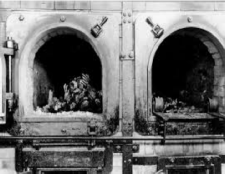
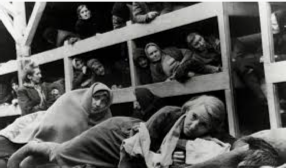
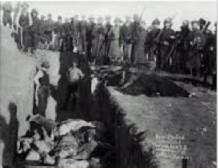
HOW TRAINS WERE CENTRAL
IN THE OPERATION
OF THE HOLOCAUST |
HOW TRAINS CHANGED
THE WORLD
Discovery UK 2019 (7.38)
As weapons, trains transformed the modern battlefield in heroic and horrible ways. The railways were used to transport minorities and anyone who stood against the Nazi regime to the concentration camps.
SEVERAL RAILS FROM POLAND USED DURING HOLOCAUST
TO TRANSPORT
NAZI TRAINS TO AUSCHWITZ
CBS Philly 2018 (2.06)
LAST TRAIN TO AUSCHWITZ
MOVIE
2019 (1.54.30)
Holocaust Social Archive
- ארכיון השואה החברתי
